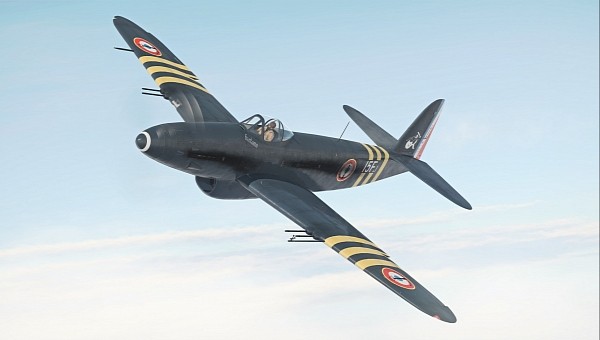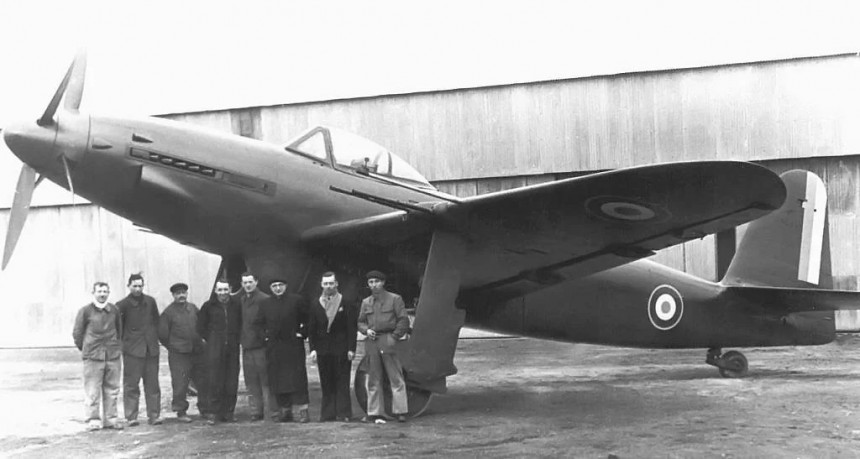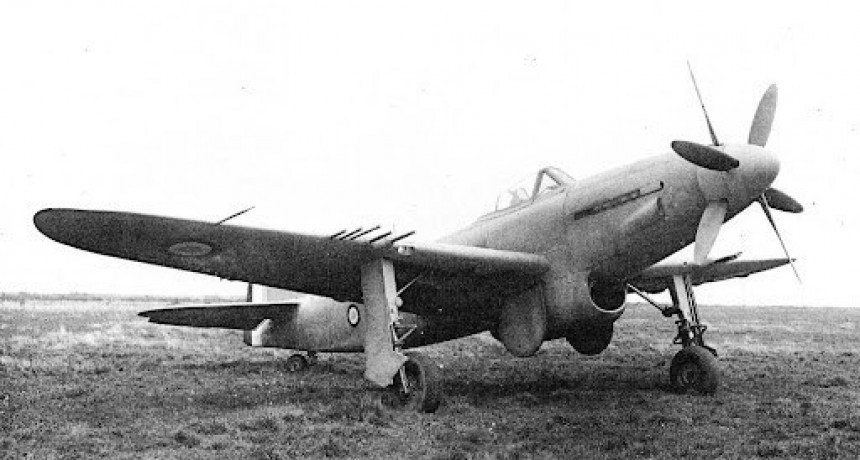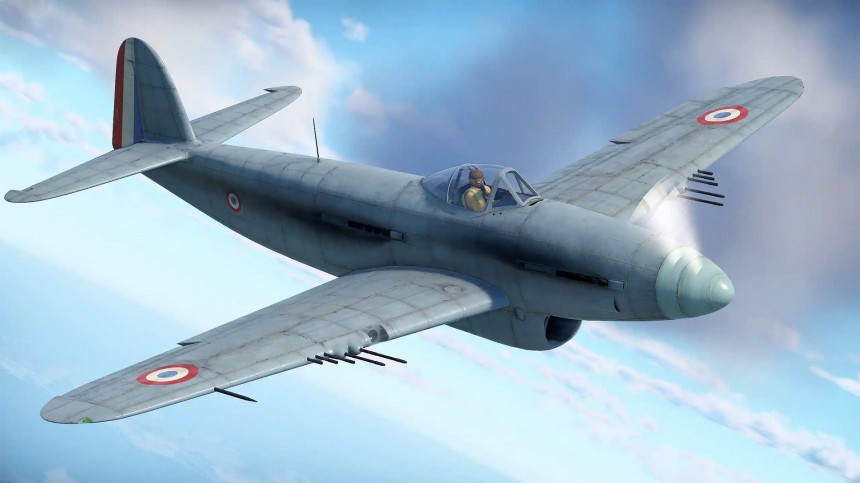"Paris outraged, Paris shattered, Paris martyred, but Paris liberated." These words left Charles de Gaulle's lips as the last Axis forces retreated out of liberated French territory in 1944. The newly free nation's first post-war domestic fighter prototype took to the skies less than 12 months later.
The aircraft in question is nothing short of an aeronautical curiosity. One that was largely forgotten by all but the most fervent French military historians. That would have been, if not for Gaijin Entertainment and their flagship arcade military vehicle simulator War Thunder. This is the story of the Arsenal VB-10. The French Post War superprop fighter you've likely never seen before.
Like the pride of the French People post-Parisian-liberation, the Air Forces of a newly freed French Military were about to undergo something of a renaissance after WWII. Surplus British and American fighter planes like Spitfires, Mustangs, Thunderbolts, and Hellcats helped to supplement depleted piston fighter ranks in the war's dog days and shortly after.
These fighters could come at no better time for the French. As no sooner were they liberated from the Germans did their centuries-long lust for colonialism commence in earnest. Little more than two years after the last whisps of Axis forces were defeated in Paris; the French commenced an assault on their claimed territories in Indochina.
From December 1946 until August 1954, the French battled the forces of anti-French Laotian and North Vietnamese separatists that'd go on to defeat the U.S. Military less than 20 years later. All the while, the French Military longed for a domestic piston-engined superprop fighter on par with heavyweights like the Grumman F8F Bearcat, P-51H Mustang, Hawker Sea Fury, and the Seafire 47.
The type of fighter planes that could duke it out with even the earliest turbojet fighters. The types that the United Nations alliance was about to meet in abundance over the skies of Korea. But France's first attempt at a post-war domestic fighter was to have its roots in a project that pre-dated the entire war by a full two years or so.
The design came courtesy of Arsenal de l'Aéronautique aviation company based on the current sight of Vélizy-Villacoublay Air Base in Northern France. Established in 1936, their first assignment for the French Air Ministry was known as the VG-30. A single-engine fighter in the same vein as the Hawker Hurricane or the Curtiss P-40 Warhawk.
The VG-30 came too late to defend Paris in 1940, but it did see a plethora of offshoots and derivatives before the Luftwaffe seized what remained of the fleet when the French were defeated. But another novel idea floated around Arsenal's design team at the time and during the occupation of Vichy France. An idea that called for a twin-engine interceptor with its drivetrain arranged one engine in the middle and one in the nose.
This novel warbird was given the working title of Arsenal VG-10, which called for two Hispano-Suiza 12X engines with around 650 horsepower. This was ultimately abandoned in favor of the upgraded VG20 with 900 Horsepower Hispano-Suiza 12Y engines with 900 horsepower each. Ironically, the aircraft which Arsenal chose to build as its first post-war fighter has its roots in this very pre-war design.
The Arsenal VB-10 bore a silhouette that mimics the old VG-30 but with the aspect ratio doubled and its fuselage widened like a 1990's baseball player's bicep on the maximum "therapeutic" dose of the juice. There was good reason for the VB-10 to be this chunky. Apart from a single Hispano Suiza 12Z V-12 piston engine mounted in the nose, there was another duplicate engine, the front's 1,150 horsepower was matched in the rear.
Each engine was mated to a split driveshaft which drove counter-rotating propellers that balanced out each other's torque. With a curb weight of 9,523 kg (20,995 lb) unloaded, the VB-10 exceeded the weight of a modern F-16 Fighting Falcon. This great weight couldn't have been all that great for fuel consumption. But as many as six VB-10s were manufactured between its first flight in July 1945 and 1947.
Initial test flights proved fruitful enough. A relatively high top speed of 430 mph ( 700 km/h) and a frankly decent rate of climb for an aircraft so gosh-darn huge had the French Military craving a production order of at least 200 airframes. It seemed the VB-10 was due to be France's last great prop fighter. Alas, this was around the same time that British and American jets were prepping to take on the bulk of the work for their entire respective air forces.
Jets like the British Gloster Meteor and American Lockheed Shooting Star suddenly made the VB-10 look slow and weak. This ice-cold water bath to Arsenal's designers was a clear sign their prized superprop's days were numbered. The project was canceled in 1948, and all its airframes were scrapped. From there, the VB-10 was cast off to the pages of history.
Except, that would have happened if not for the "Vive la France" Update 1.73 to Gaijin Entertainment's War Thunder. The update, which added France to the world's largest war-vehicle, arcade-style combat game, brought two separate variations of the VB-10, which saw testing back in the 40s.
With six M2 Browning Machine Guns on tap atop the four Hispano-Suiza 20 mm autocannons of the VB 10C-1, the VB-10-02 is an all-around excellent piston fighter, assuming it's auto-matched with similar opponents at its battle rating. But just like in real life, the VB-10 in any of its forms is quick to be picked apart by Shooting Stars, Meteors, MiG-9s, and just about any other starter jet in the game. So then, maybe the French were right to nip it in the bud all along.
Thanks for reading another fantastic edition of Celebration Month 2022 here on autoevolution.
Like the pride of the French People post-Parisian-liberation, the Air Forces of a newly freed French Military were about to undergo something of a renaissance after WWII. Surplus British and American fighter planes like Spitfires, Mustangs, Thunderbolts, and Hellcats helped to supplement depleted piston fighter ranks in the war's dog days and shortly after.
These fighters could come at no better time for the French. As no sooner were they liberated from the Germans did their centuries-long lust for colonialism commence in earnest. Little more than two years after the last whisps of Axis forces were defeated in Paris; the French commenced an assault on their claimed territories in Indochina.
From December 1946 until August 1954, the French battled the forces of anti-French Laotian and North Vietnamese separatists that'd go on to defeat the U.S. Military less than 20 years later. All the while, the French Military longed for a domestic piston-engined superprop fighter on par with heavyweights like the Grumman F8F Bearcat, P-51H Mustang, Hawker Sea Fury, and the Seafire 47.
The design came courtesy of Arsenal de l'Aéronautique aviation company based on the current sight of Vélizy-Villacoublay Air Base in Northern France. Established in 1936, their first assignment for the French Air Ministry was known as the VG-30. A single-engine fighter in the same vein as the Hawker Hurricane or the Curtiss P-40 Warhawk.
The VG-30 came too late to defend Paris in 1940, but it did see a plethora of offshoots and derivatives before the Luftwaffe seized what remained of the fleet when the French were defeated. But another novel idea floated around Arsenal's design team at the time and during the occupation of Vichy France. An idea that called for a twin-engine interceptor with its drivetrain arranged one engine in the middle and one in the nose.
This novel warbird was given the working title of Arsenal VG-10, which called for two Hispano-Suiza 12X engines with around 650 horsepower. This was ultimately abandoned in favor of the upgraded VG20 with 900 Horsepower Hispano-Suiza 12Y engines with 900 horsepower each. Ironically, the aircraft which Arsenal chose to build as its first post-war fighter has its roots in this very pre-war design.
Each engine was mated to a split driveshaft which drove counter-rotating propellers that balanced out each other's torque. With a curb weight of 9,523 kg (20,995 lb) unloaded, the VB-10 exceeded the weight of a modern F-16 Fighting Falcon. This great weight couldn't have been all that great for fuel consumption. But as many as six VB-10s were manufactured between its first flight in July 1945 and 1947.
Initial test flights proved fruitful enough. A relatively high top speed of 430 mph ( 700 km/h) and a frankly decent rate of climb for an aircraft so gosh-darn huge had the French Military craving a production order of at least 200 airframes. It seemed the VB-10 was due to be France's last great prop fighter. Alas, this was around the same time that British and American jets were prepping to take on the bulk of the work for their entire respective air forces.
Jets like the British Gloster Meteor and American Lockheed Shooting Star suddenly made the VB-10 look slow and weak. This ice-cold water bath to Arsenal's designers was a clear sign their prized superprop's days were numbered. The project was canceled in 1948, and all its airframes were scrapped. From there, the VB-10 was cast off to the pages of history.
With six M2 Browning Machine Guns on tap atop the four Hispano-Suiza 20 mm autocannons of the VB 10C-1, the VB-10-02 is an all-around excellent piston fighter, assuming it's auto-matched with similar opponents at its battle rating. But just like in real life, the VB-10 in any of its forms is quick to be picked apart by Shooting Stars, Meteors, MiG-9s, and just about any other starter jet in the game. So then, maybe the French were right to nip it in the bud all along.
Thanks for reading another fantastic edition of Celebration Month 2022 here on autoevolution.













